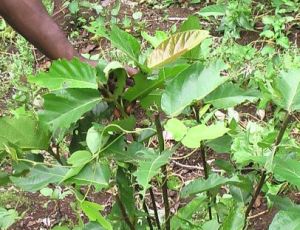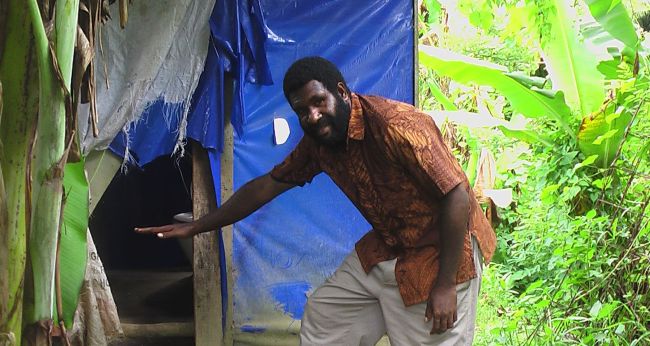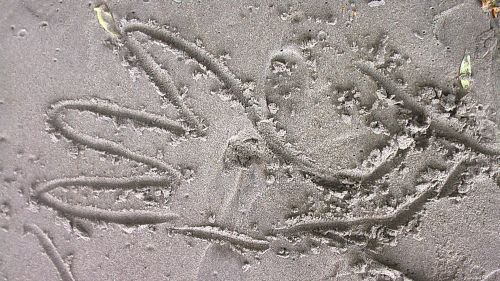
Article from http://creation.com/more-dino-sightings-png
Published: 23 August 2012 (GMT+10)
|
Following on from his 2008 article Theropod and sauropod dinosaurs sighted in
PNG?, in January 2012 the author Brian Irwin
along with Russell Cook (both Australians) travelled to West New
Britain in Papua New
Guinea to investigate further reports of animals presumed to be extinct.
Here is an account of their conversations with eyewitnesses—local
people who claimed to have recently seen
dinosaur-like creatures. |
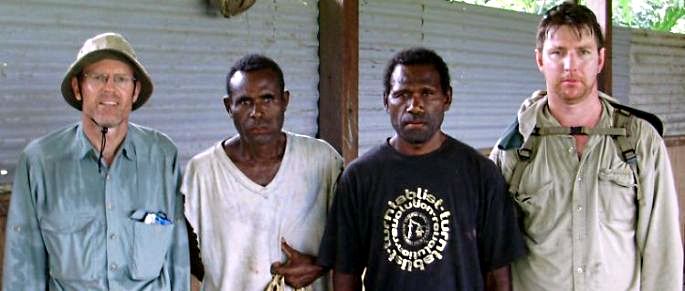
Figure 1: The author, Brian Irwin (left), with Russell Cook (right) at Gasmata, West New Britain, Papua New
Guinea, with locals Fabian Amon (second from left), and Matthew—local politician and interpreter (second from right).
Sauropod sightings in the south and north of West New Britain
1. Ambungi Island Sightings
The inhabitants of Ambungi Island1 and the surrounding region have observed unusual animals that resemble sauropod dinosaurs since the mid-1990s. Ambungi Island is located about two kilometres south of the south coast of West New Britain, approximately midway between Kandrian and Gasmata. It is only since the 1920s that Ambungi Island has been populated.Swimming with a sauropod?
A local man named Alphones Likky (interviewed on 15th January 2012—see Figure 2) claimed to have seen a sauropod-like creature in 1995 while he was spearfishing on the reef on the south side (unpopulated) of Ambungi Island.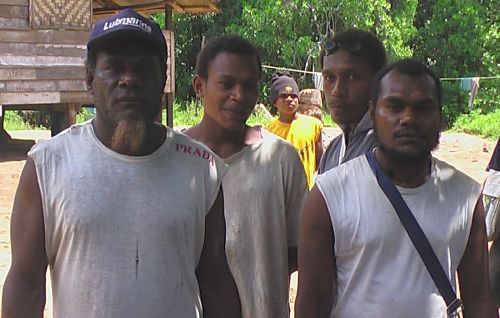
Figure 2: While diving on a reef off
Ambungi Island in 1995, Alphones Likky (far left) was startled to see a
large sauropod-like creature about
five metres away.
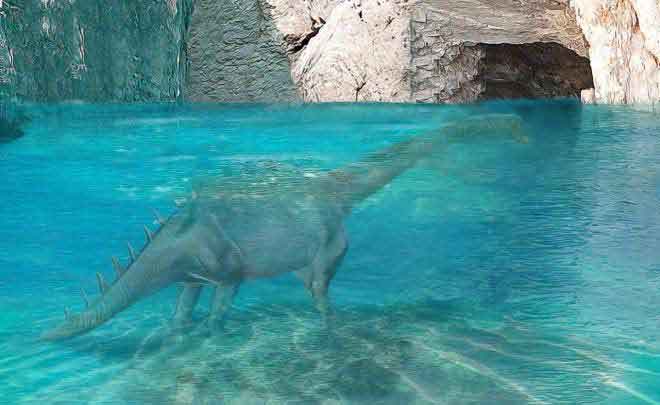
Figure 3: An artist’s reconstruction of the animal seen entering an underwater cave on the south
side of Ambungi Island.
Seeing the creature at such close range and being in the water with it, Alphones was terrified.
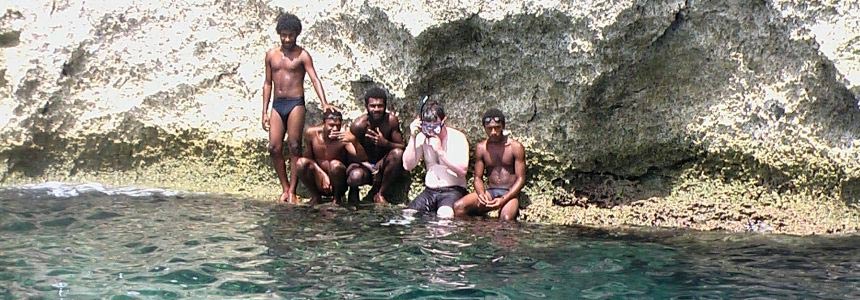
Figure 4—At the foot of the cliff on the south side of Ambungi Island near the two underwater
caves referred to in the main text. Above: Russell
Cook, donning the mask and snorkel, is preparing
to take a quick look at the cave entrances, and the nearby coral. Below:
As Mr Cook enters the water,
part of the entrance to the
left cave (the one the creature was seen entering) can be seen at right.
(These two photos guided the artist’s illustration of the background
landscape of Figure 3.)
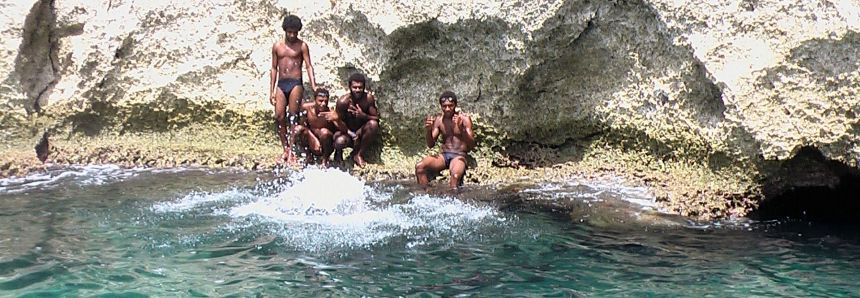
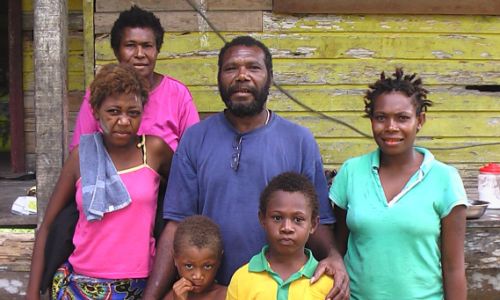
Figure 5: Alice Pasington (top left) tells of encountering a dinosaur in her garden.
A dinosaur in the garden?
In 1999 the second good sighting of one of these creatures occurred, however on this occasion the animal was observed on the land.Alice Pasington (interviewed on 14th January 2012) was working alone in the garden on the south side of the island when she claims to have had an unusual encounter. From a distance of about 40 metres, Alice observed one of the creatures and estimated the total length to be about three metres. (See artist’s reconstruction in Figure 6.)
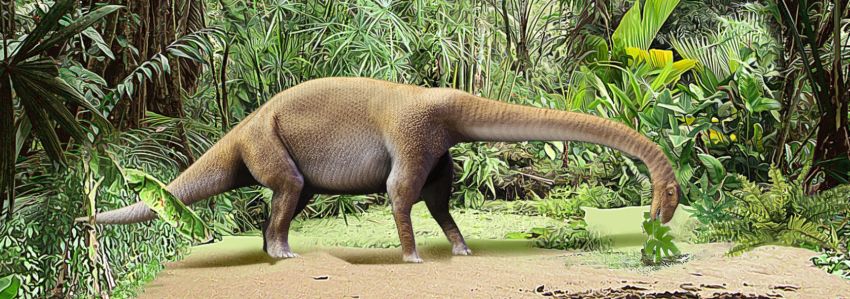
Figure 6: An artist’s reconstruction of
the three-metre animal that Alice Pasington says she saw
while working
in the garden about 40 metres away.
Alice then observed the animal turn around and walk to a small cliff, where it dived into the sea. During this time, the creature was followed at a distance and did not seem aware of Alice’s presence. After the animal had left the garden, Alice observed the five-toed footprints in the ground and later showed these footprints to other residents of Ambungi Island. The animal may have entered the garden from the beach on the western side of the island during the night. From the above description, it is possible that it may have been a juvenile specimen of the same type of creature as the other sightings, based on its size, colour, footprint and smooth skin texture.
Sleeping on a rock
Once the animal heard the sound of people, it moved from the rock back into the sea.
Similar animals have also been observed on islands close to Ambungi Island.
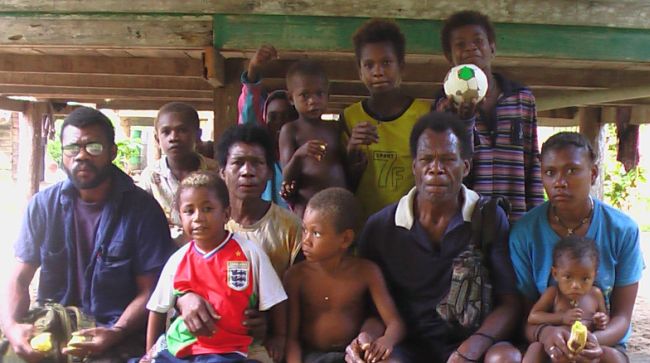
Figure 8: Joe and Jasinta Pitim
observed a large aquatic animal sunning itself on a rock on a reef
off
Ambungi Island in 2007. They had seen the head and
neck of a similar creature protruding
above the sea while travelling by
canoe ten years earlier.
2. Gasmata sighting
A creature similar to the one(s) observed around Ambungi Island has also been seen once near Gasmata. One afternoon in August 2004, three adults—Fabian Amon (see Figure 1), Simon Patolkit2 (Figure 9) and Margaret Patolkit—along with some children observed a sauropod-like creature on the south side of Dililo Island, an unpopulated island used mainly for farming by the local people from Gasmata.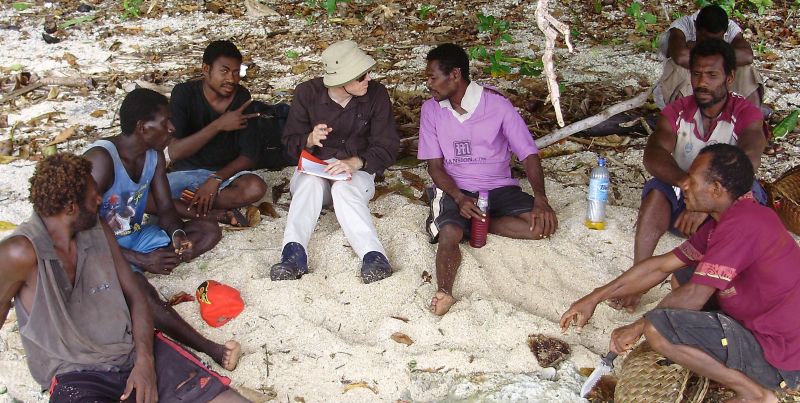
Figure 9: The gentleman at the far left
of this photo is Simon Patolkit, who along with his wife
Margaret and
others observed a huge creature in the sea off
Gasmata. (See Figure 10.)
Simon, Margaret and Fabian were diving for fish on the reef on the south side of Dililo Island when they heard an unusual sound in the water and noticed that the fish were scattering. They became somewhat frightened by this incident and left the water for the safety of the land. A short time later, while sitting on some rocks, they observed part of an unknown animal above the water about 40–50 metres away and travelling in an east-west direction parallel to the coast.
The creature had a large body and a neck estimated to be three metres long that was horizontal and close to the water. No tail or legs were visible and the total length of the visible portion of the animal was about eight metres. The head was like a crocodile or lizard and the eye was described as being ‘big’. The colour of the animal was uniform brown and the skin had a rough texture. The animal was described as having a ‘saw’ in the middle of its back, which consisted of 4 or 5 dermal frills. Observation time lasted about one minute during which time the creature moved slowly until it submersed itself fully in the water.

Figure 10: An artist’s reconstruction of
the creature observed at Gasmata Reef. It held its head and
neck (about
3 metres long) just above the water and
was described as having a ‘saw’ in the middle
of its back. The visible
part of the creature was estimated to be about 8 metres (26 feet) in
length—
but its total body length
was likely considerably greater, given its tail was submerged and out of
view.
3. Possible theropod sighting in the north of West New Britain
A small theropod-like creature that local people have dubbed ‘Doren’ has been repeatedly observed around Benaule Village3, which is located approximately 25 km east of Kimbe on the north coast of West New Britain. The creature has been seen quite frequently for many years, with a close encounter reported in November 2010.Pastor Ken-John was sitting on an ‘outhouse’ toilet at the Tabernacle Of Worship church during the day when he observed the profile of the head and upper torso of the ‘Doren’ appear only one metre away, just outside. The head was described as being like that of an aircraft (presumably like the profile of the nose of a jet, such as a 747) and the colour was medium brown. The animal has also been seen on the seashore near the church grounds by local people, where it comes ashore during high tide and travels back to the sea during low tide.
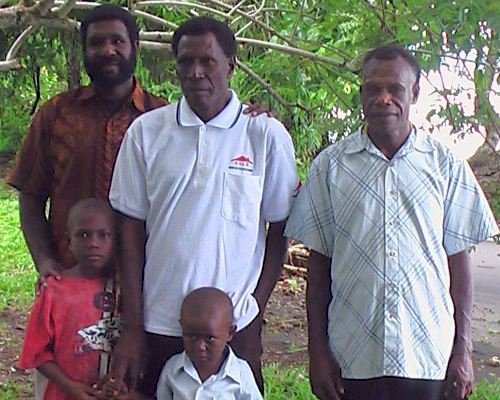
Figure 12: Pastor Ken-John stands by the
sea in the grounds of the Tabernacle of Worship church, showing where
he says the ‘Doren’ comes ashore
at high tide. With him are Ben (the landowner) and John.
The ‘Doren’ has been observed eating crabs and digging up vegetables from a garden.
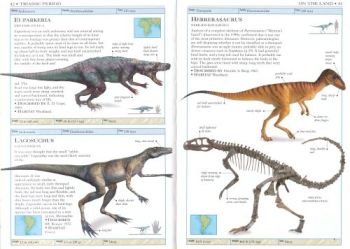
Figure 14: A scan of pages from the 2003 evolutionary dinosaur handbook by H. Richardson, Dinosaurs and prehistoric life, showing a scientific
illustration of Herrerasaurus (on the right-hand page). Click for larger image.

